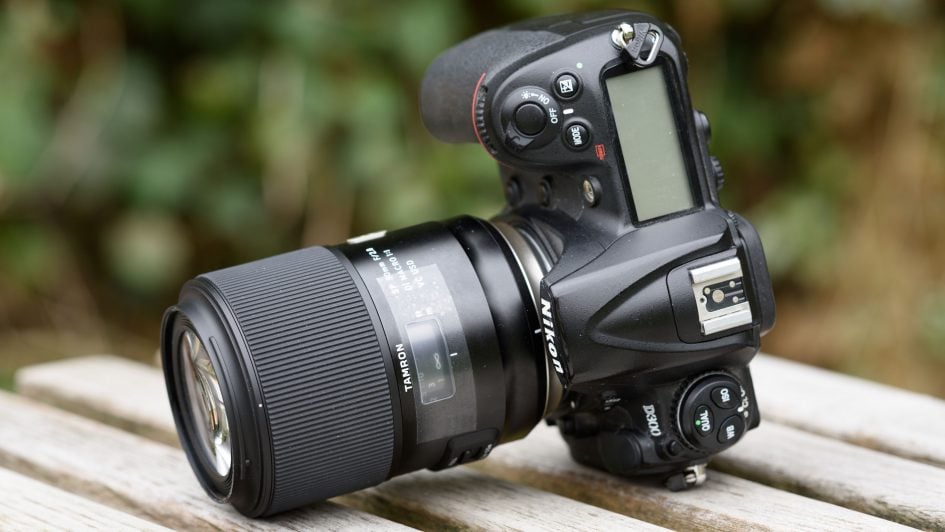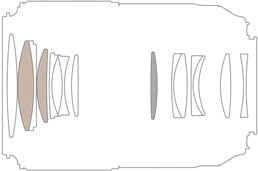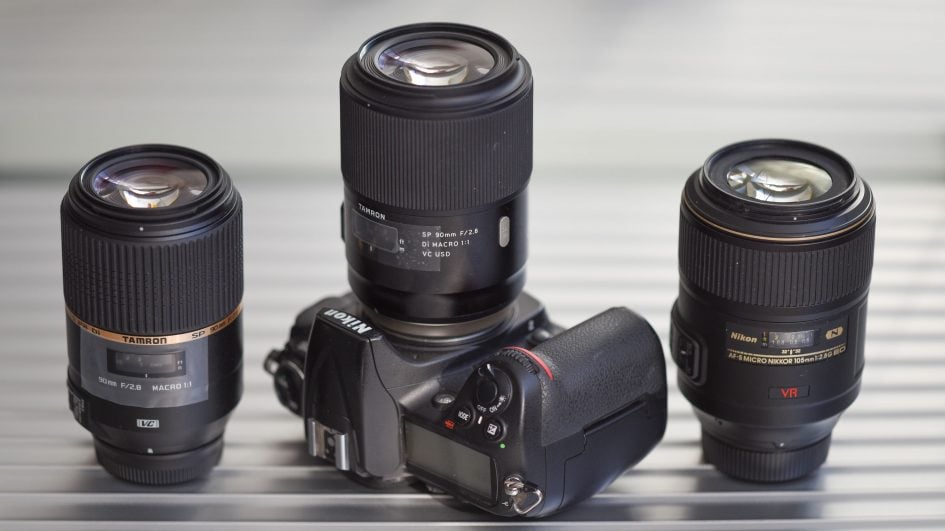Summary
 The new Tamron 90/2.8 Large VC ii is a very likeable lens: It combines selfsame good optical performance with very good image stabilization and beats the venerable Nikon 105/2.8G in all but any respect. Its autofocus is trusty (after some tweaking) and the lens performs equally well from close-up to landscapes. As such it easy earns a Extremely Recommended.
The new Tamron 90/2.8 Large VC ii is a very likeable lens: It combines selfsame good optical performance with very good image stabilization and beats the venerable Nikon 105/2.8G in all but any respect. Its autofocus is trusty (after some tweaking) and the lens performs equally well from close-up to landscapes. As such it easy earns a Extremely Recommended.
Pip out now!
Check prices on the Tamron 90mm f2.8 II at Amazon, B&H, Adorama, or Wex. Alternatively get yourself a copy of my In Television camera book surgery treat me to a coffee! Thanks!
Tamron 90mm f2.8 VC Deuce brushup -
- Written by
In depth
The Tamron SP 90mm f2.8 Di Macro VC USD is a stabilized full-frame macro lens available in Canon, Nikon, and Sony A mount up. Announced in February 2016, it's already the second iteration of Tamron's stabilized 90mm macro from 2012 claiming improved stabilization from a newly added XY-shift compensation and improved weather sealing. The new lens is too matched with Tamron's new USB dock for satisfactory-tuning AF and VC or microcode updates, called the TAP-in Comfort. To distinguish the new variant from the old I selected the new lens as "VC ii" throughout this review. The official Tamron moniker for the fres electron lens is "mannequin F017" the old one being "model F004". Image stabilisation of fixed focal lenses below 100mm length is an important impress that reflects the development of of all time-high mega pixel count sensors. With 36MP, 42MP and 50MP full-frame sensors too as 24MP APS-C/DX sensors it is increasingly effortful to reach really sharp shots devoid of (micro-)smutch. The old 1/point-length rule for shutter-speeds that are on the unhurt pull zero longer applies for the pixel-densities of modern sensors: today we're more talking just about using 1/200 sec on a macro lens of 90-105mm focal length. Just with a good image stabilization (dubbed "Vibration Manipulate"/VC aside Tamron) in that respect's hope to become sharp shots hand-held at around 1/25 second at normal magnifications. But with macro lenses you have two extra challenges: shake becomes more pronounced the larger the overstatement, plus normally you need to stop go through further to reach a decent depth of field. That's why many photographers depend on tripods for their macro work. Soh it'll be interesting to see whether Tamron managed to implement an effective image stabilizer and first-class optical contrive to differentiate itself from opposite stabilized long-wooled macro lenses.
To see impossible how it performed I tested the Tamron SP 90mm f2.8 Macro VC ii on Nikon's 36MP D810 and compared the results against Nikon's ain AF-S 105mm f/2.8G ED Micro Nikkor and the predecessor from Tamron model F004.
PS – Don River't forget you can abide my work next time you order anything at Virago, B&H or Adorama by first clicking through to them using the links above and in the sidebar. IT works for love or money you order at any time – thanks for your support!

Facts from the catalog
As usual I'll have a look at the technical data first. I've rated the features with a [+] (Beaver State [++]), when it's break than average or even tell of the artistic production, a [0] if it's orthodox or just average, and [-] if on that point's a disfavor. I'll compare information technology with the AF-S small Nikkor 105/2.8G ED (the "Nikon 105/2.8" for curtly).
Size (diam. x length): 79 x 117mm (3.1 x 4.6in). The lens hood adds other 58mm. Which is par for the course: The Nikon 105/2.8 is 83 x 116mm resp. 192mm distance including lens hood. [0]
Weightiness: 610g (22.5 oz). This is lighter than the Nikon 105/2.8 which comes in at 750g. [+]

Optics: 14 elements in 11 groups. This is look-alike to the Nikon 105/2.8 with 14 elements in 12 groups. The lens design and the MTF curves look exactly the same as with its predecessor. It includes tercet low dispersion elements and finish with a nano-integrated layer. Plus fluorine coating at the front lens system for easier cleaning. [+]
Closest focus distance/max. magnification: 0.29m (11.4in) / 1:1. So this is a "real" big lense, non some of the zooms claiming to be "big"-designs but only reaching a maximum magnification of 1:3 Beaver State thereabouts. The operative distance betwixt the front element and the subject is 14cm at 1:1 magnification (22cm at 1:2). The Nikon 105/2.8 reaches 1:1 at 0.31m, its operative distance is 15cm (24cm at 1:2). The focal ratio of the Tamron shrinks from f2.8 to f5.6 at 1:1 enlargement (f4.2 at 1:2). The Nikon shrinks to f4.8 at 1:1 (f3.3 at 1:2). I wouldn't overestimate the differences in focal ratio when focusing nigher. The major plus of this lens (and the Nikkor) is its 1:1 magnification. [+]
Filter-thread: 62mm. Those filters are cheaper than the professional touchstone 77mm filters which are wide used. Merely chances are you may not have this sizing nonetheless. Assonant with the Nikon 105/2.8. [0]
Image stabilization: Yes (except when you buy the Sony rendering which relies along the body-supported stabilization of the latest models). The Nikon 105/2.8 also has ocular stabilization. [+]
Autofocus: USD (Unhearable Unarticulate Drive out), so it as wel works connected bodies that don't have a intrinsical AF drive away like the Nikon D3x00/5×00. Blue-collar-focus override is by plainly turning the focus ring. Same with the competition. The lens has a limiter switch terzetto positions: "sperm-filled", "0.5m – infinity", "0.3m – 0.5m". This should prevent the lens from hunting around. The Nikon 105/2.8 has a limiter with ii positions: "full", "0.5m – infinity". [+]
Covers full frame/FX or smaller = very good. Same with the competition. [+]
Price: around 800 EUR new (incl. 19% Ad valorem tax) merely I've already seen a street prices below that. It's predecessor presently goes for 400 EUR. So this looks like a huge mark-up over its predecessor for an cleared image stabilisation, although in more or less regions the pricing is lower for the new model. The Nikon 105/2.8 can be had for 800 EUR. [-]
Comes with no incase but the lens hood is included and reversible for transport, the lens caps are are similar to Nikon's pincer-type. Wherefore Tamron definite to deliver a 800 EUR lens without a lens case is beyond me. [-]
Distance selective information is relayed to the camera, so the Nikon body crapper DO all the advanced exposure-related stuff with this genus Lens. Same with the contender. [+]
Aperture ring: no. Same as with all the other alternatives. [0]
Waterproofing: A prophylactic grommet at the electron lens-mount and additional sealing. Plus fluorine coating at the advanced lens for easier cleaning. [+]
The score in the "features-section" is 2[-]/3[0]/8[+]. In direct comparison to the Nikon 105/2.8 the new Tamron 90/2.8 Macro VC cardinal looks beautiful similar with the fluorine coating of the front lens fashioning up for the nonexistent lens case. Compared to its predecessor the lens features fluorine coating, improved image stabilization, weather sealing plus compatibility with the TAP-in solace for fine-tuning only optical performance should be the same. And so double the damage of the lens seems like a bold move.
Three stabilized large lenses for full-frame bodies

In a higher place from left to decent: Tamron SP 90/2.8 Di Macro instruction VC model F004 and F017, Nikon Micro-Nikkor 105/2.8G ED VR
Alternatives
– Nikon offers the AF-S Nikkor 105/2.8G ED VR. It was the prime stabilized big on the commercialise and costs around 800 EUR. IT earned a Highly Recommended in my Nikon 105/2.8G VR review articl. At that place's as wel the Nikon AF-S VR DX Micro 85mm 3.5G IF-ED at 450 EUR simply it only covers a DX sensor and has a 2/3 stop lower central ratio. It earned a Advisable in my Nikon DX 85/3.5G VR review.
– From Canon there is the EF 100mm 2.8 L Macro IS USM for 770 EUR. It's from 2009 and of similar size and weight as the Tamron.
– From Sony mirrorless cameras, there's the Iron 90mm f2.8 Macro with sense organ stabilization for close to 999 EUR which performed very well in Gordon's tests with the A7r Mark II.
– Sigma offers three stabilized f2.8 macro lenses at 105mm (420 EUR), 150mm (900 EUR), and 180mm (1500 EUR). All three cover full-format sensors with the longer central lengths oblation longer working distances. And piece the Sigma AF 105mm 2.8 EX DG OS HSM Macro is only slightly larger and heavier than the Tamron, the Sigma AF 150mm 2.8 Antique DG APO HSM OS Macro is already a 1.2kg lense and the 180mm sibling weighs in at 1.6kg.
– Tamron's ain predecessor F004 bum tranquil be had and looks like a bargain at 400 EUR. But supplies are unfree to mummify shortly. And than there is a plethora of non-stabilized macros also from Samyang (extremity focus on only) and Tokina. When shopping for the Tamron lens, be sure to confirm if information technology's the new framework F017, or the gray-haired model F004.
Direction and image stabilization
Focus truth and repeatability is critical to consistently produce piercing shots. Repeatability (the accuracy of focus on the same open later continual focus-acquisition) of this electron lens is good (measured 96,9% in FoCal) with cardinal mild outliers terminated a series of 40 shots. But you better stimulate sure that you fine-tuned autofocus: I had 4 real outliers in 20 shots before I focused the fine-melody value past only 5 units.
The electron lens focuses in under 0.4 sec from infinity to 0.9m which is very fast. The 40mm broad pore ring has only a very tiny spot of slack/play between its movement and the focus-natural action. Its movement is of medium suaveness. Focus fuddle is a long 190 degrees but manual focusing at bulky apertures is tranquil tough-skinned because simply around 15 degrees of throw is accustomed focus 'tween infinity and 1m. It turns the same means as Canon photogs are accustomed but that is the wrong elbow room for Nikon users. AF-operation is barely audible from the outside and if you criminal record video recording with the intrinsical microphone there's exclusive a slight "tock" at the beginning of direction-movement and the AF-drive is very unpretending. The image stabilizer is virtually inaudible on the after-school and when recording picture in that location's only a faint noise recorded. If you pull focus e.g. from infinity to 1m you'll notice some total of focus breathing: the exaggeration increases by 18%.
To essa the effectualness of the image stabilization I did a series of 100 test-shots handheld at my usual magnification of 1:40 (outstrip being around 3.6m). Shutter speeds were from 1/100 of a second down to 1/12 second. Comparing the shots with VC=ON with a reference sample of 20 shots at 1/100 unsweet with VC=OFF I fanny report that the VR is easily well for 3 stops of image-stabilization. That is a very just lead and a main welfare compared to non-stabilized lenses. It means you tail shoot around 1/10 sec and still get a very high custodian-range. I did a similar mental testing at a magnification of 1:5 (around 0.5m distance) to view whether the VC was also in force in damping shake at close-up shots. As overstatement is 8 multiplication higher than in the normal test I used 20 shots at 1/200 with VC=Turned as a reference sample. Low these conditions the VC was proficient for or so 2 Michigan of image stabilisation, that is at 1/50 s you could accomplish results that were on average as edged as the unstabilized results at 1/200 sec.
Pages: 1 2 3 4
Tamron 90mm f2.8 VC II review
Source: https://www.cameralabs.com/tamron-sp-90mm-f2-8-di-vc-usd-macro-review/
Posting Komentar